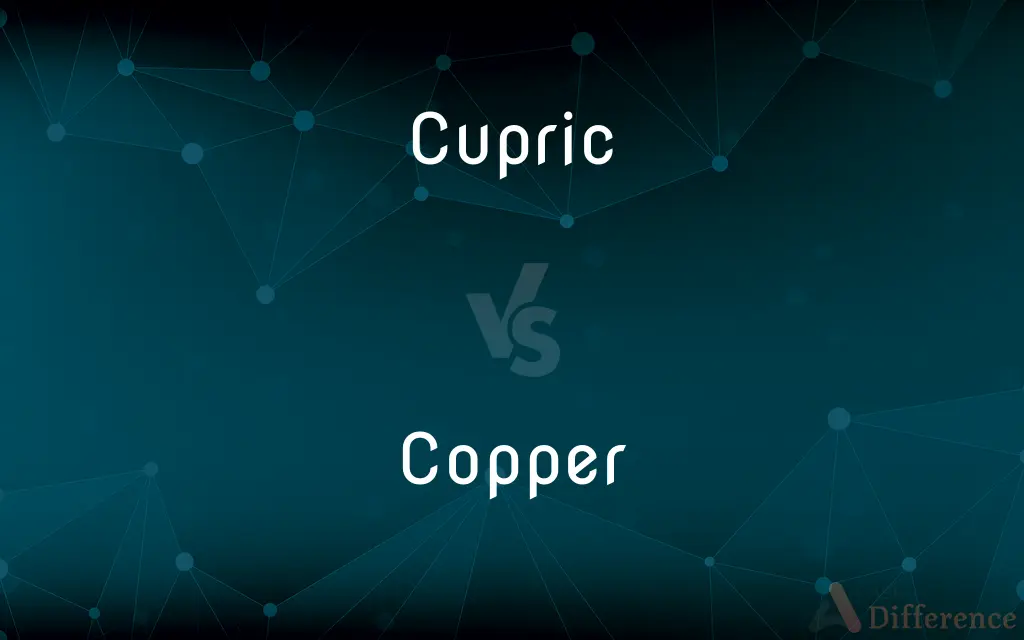Cupric vs. Copper — What's the Difference?
By Tayyaba Rehman & Maham Liaqat — Updated on April 4, 2024
Cupric refers to copper in its +2 oxidation state, essential for various chemical reactions, while copper is a versatile metal used in electrical wiring and plumbing.

Difference Between Cupric and Copper
Table of Contents
ADVERTISEMENT
Key Differences
Cupric compounds contain copper in a +2 oxidation state, making them vital for specific biochemical and industrial processes. In contrast, copper is a naturally occurring element (Cu) known for its high thermal and electrical conductivity.
Cupric ions are soluble in water and form blue or green solutions, indicating their presence in various chemical reactions. Whereas copper, in its elemental form, exhibits a distinct reddish-brown color, making it easily recognizable and widely used in art and architecture.
Cupric sulfate, a common cupric compound, is used as an algicide and fungicide in agriculture. On the other hand, copper is utilized in the manufacturing of electrical wires due to its excellent conductivity.
Cupric oxide is another example, serving as a catalyst in chemical reactions. Meanwhile, copper alloys, such as bronze and brass, play a crucial role in musical instruments and decorative items.
Cupric compounds are essential in the human body for supporting enzymatic reactions and facilitating iron absorption. Conversely, copper metal is used in water piping systems for its antimicrobial properties and corrosion resistance.
ADVERTISEMENT
Comparison Chart
Oxidation State
+2
0 (Neutral)
Solubility
Soluble in water, forming blue or green solutions
Insoluble in water
Uses
Chemical reactions, biochemical roles
Electrical wiring, plumbing, art
Color in Compounds
Blue or green
Reddish-brown (in elemental form)
Examples
Cupric sulfate, cupric oxide
Copper wire, copper pipes
Compare with Definitions
Cupric
Found in enzymes as an essential trace element.
Cupric ions facilitate important biochemical reactions.
Copper
Found in natural mineral forms.
Copper ores are mined for metal extraction.
Cupric
Integral to the catalysis of chemical reactions.
Cupric oxide is a catalyst in the synthesis of fine chemicals.
Copper
Used in coinage and jewelry.
Copper coins have been in circulation for centuries.
Cupric
Involving copper ions in solution.
Cupric solutions are utilized in laboratory experiments for their distinct colors.
Copper
Essential for manufacturing alloys.
Copper is a primary component of bronze.
Cupric
Related to compounds used in agriculture.
Cupric fungicides protect crops from fungal diseases.
Copper
Exhibits antimicrobial properties.
Copper surfaces are used in hospitals to reduce infection transmission.
Cupric
Pertaining to copper with a valence of two.
Cupric sulfate is used to control algae in ponds.
Copper
A reddish-brown metal known for conductivity.
Copper wiring is essential in electrical circuits.
Cupric
Of copper with a valency of two; of copper(II).
Copper
Copper is a chemical element with the symbol Cu (from Latin: cuprum) and atomic number 29. It is a soft, malleable, and ductile metal with very high thermal and electrical conductivity.
Cupric
Relating to or containing copper, especially with valence 2.
Copper
Symbol Cu A ductile, malleable, reddish-brown metallic element that is an excellent conductor of heat and electricity and is widely used for electrical wiring, water piping, and corrosion-resistant parts, either pure or in alloys such as brass and bronze. Atomic number 29; atomic weight 63.546; melting point 1,085°C; boiling point 2,562°C; specific gravity 8.96; valence 1, 2. See Periodic Table.
Cupric
Of, pertaining to, or derived from, copper; containing copper.
Copper
A coin, usually of small denomination, made of copper or a copper alloy.
Cupric
(chemistry) Containing copper with an oxidation number of 2
Copper
Chiefly British A large cooking pot made of copper or often of iron.
Cupric
Of, pertaining to, or derived from, copper; containing copper; - said of those compounds of copper in which this element is present in its lowest proportion.
Copper
Any of various small butterflies of the subfamily Lycaeninae, having predominantly copper-colored wings.
Cupric
Of or containing divalent copper
Copper
A reddish brown.
Copper
A police officer.
Copper
To coat or finish with a layer of copper.
Copper
(Slang) To bet against, as in faro.
Copper
(uncountable) A reddish-brown, malleable, ductile metallic element with high electrical and thermal conductivity, symbol Cu, and atomic number 29.
Copper
The reddish-brown colour/color of copper.
Copper
Any of various specialized items that are made of copper, where the use of copper is either traditional or vital to the function of the item.
Copper
(countable) A copper coin, typically of a small denomination, such as a penny.
Copper
A large pot, often used for heating water or washing clothes over a fire. In Australasia at least, it could also be a fixed installation made of copper, with a fire underneath and its own chimney. Generally made redundant by the advent of the washing machine.
Mum would heat the water in a copper in the kitchen and transfer it to the tin bath.
I explain that socks can’t be boiled up in the copper with the sheets and towels or they shrink.
Copper
(entomology) Any of various lycaenid butterflies with copper-coloured upperwings, especially those of the genera Lycaena and Paralucia.
Copper
A police officer.
Copper
Made of copper.
Copper
Having the reddish-brown colour/color of copper.
Copper
To sheathe or coat with copper.
Copper
A common metal of a reddish color, both ductile and malleable, and very tenacious. It is one of the best conductors of heat and electricity. Symbol Cu. Atomic weight 63.3. It is one of the most useful metals in itself, and also in its alloys, brass and bronze.
Copper
A coin made of copper; a penny, cent, or other minor coin of copper.
My friends filled my pockets with coppers.
Copper
A vessel, especially a large boiler, made of copper.
Copper
The boilers in the galley for cooking; as, a ship's coppers.
All in a hot and copper sky.
Copper
To cover or coat with copper; to sheathe with sheets of copper; as, to copper a ship.
Copper
A ductile malleable reddish-brown corrosion-resistant diamagnetic metallic element; occurs in various minerals but is the only metal that occurs abundantly in large masses; used as an electrical and thermal conductor
Copper
A copper penny
Copper
Uncomplimentary terms for a policeman
Copper
A reddish brown the color of polished copper
Copper
Any of various small butterflies of the family Lycaenidae having copper colored wings
Copper
Coat with a layer of copper
Common Curiosities
How do cupric compounds differ from elemental copper in terms of solubility?
Cupric compounds are generally soluble in water, forming blue or green solutions, unlike elemental copper, which is insoluble.
Can copper exist in oxidation states other than +2?
Yes, copper can exist in other oxidation states, but +2 (cupric) and +1 (cuprous) are the most common.
What are some common cupric compounds and their uses?
Common cupric compounds include cupric sulfate (used as an algicide) and cupric oxide (used as a catalyst).
What are the main uses of copper?
Copper is widely used in electrical wiring, plumbing, and as a material in various alloys.
How does copper's conductivity compare to other metals?
Copper has one of the highest electrical and thermal conductivities among engineering metals.
What is cupric?
Cupric refers to copper ions or compounds where copper has a +2 oxidation state.
Are cupric compounds found in the human body?
Yes, cupric ions are essential for various enzymatic activities and iron absorption in the human body.
What is the significance of copper's color?
Copper's distinct reddish-brown color is a characteristic feature that also aids in its identification in art and architecture.
Why is copper preferred in electrical wiring?
Copper is preferred for its excellent thermal and electrical conductivity.
How are copper alloys beneficial in musical instruments?
Copper alloys like bronze and brass are valued in musical instruments for their acoustic properties.
Is copper toxic to humans?
In small amounts, copper is essential for health, but high doses can be toxic.
What environmental impact does copper mining have?
Copper mining can have significant environmental impacts, including habitat destruction and pollution.
Can cupric compounds be used for medicinal purposes?
Yes, cupric compounds have applications in medicine, especially in antimicrobial treatments.
What role do cupric ions play in agriculture?
Cupric ions are used in fungicides and algicides to protect crops and water bodies from fungal diseases and algae.
Are cupric compounds used in water treatment?
Yes, cupric sulfate and other compounds are used in water treatment to control microbial growth.
Share Your Discovery

Previous Comparison
Elegy vs. Dirge
Next Comparison
Helmsman vs. SteersmanAuthor Spotlight
Written by
Tayyaba RehmanTayyaba Rehman is a distinguished writer, currently serving as a primary contributor to askdifference.com. As a researcher in semantics and etymology, Tayyaba's passion for the complexity of languages and their distinctions has found a perfect home on the platform. Tayyaba delves into the intricacies of language, distinguishing between commonly confused words and phrases, thereby providing clarity for readers worldwide.
Co-written by
Maham Liaqat













































